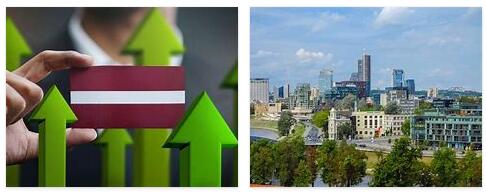The economy, nationalized immediately after the Second World War, following the independence achieved in September 1991, it initiated the transition to the market system, with the difficulties deriving from the strong interdependence consolidated during the previous fifty years, in a context of relative sectoral specialization with the other former Soviet republics. The country’s difficulties largely depend on the lack of internal resources (if we exclude those provided by a primary sector, which is in any case in serious contraction). Russia’s sharp decline in supplies of raw materials and oil has brought many companies to their knees, and the leadership of the industrial sector has gradually shifted to trade and financial activities. Despite the undoubted potential of Latvian society, the development prospects of the economy, after the declaration of independence, were dominated by elements of uncertainty: the choice not to participate even in the commercial coordination projects between the former Soviet republics for the country involved both a strong increase in production costs, due to the payment of fuels according to international prices, and greater difficulties in exporting to those traditional markets, connected to the imposition of customs tariffs, while commercial integration with Western economies was penalized by the accumulated technological disadvantage and the low quality of local products. The requests for funding and insertion into the European Union initially found a less effective reception than hoped for and only materialized in the OECD.
Even the hypotheses for the establishment of a Baltic free trade area have had a troubled beginning: so far cooperation has concerned only some environmental issues. The adoption of a national currency, the lat, in 1993 triggered very high levels of inflation, which then gradually decreased; a not secondary effect of the financial evolution was the diversion of capital on speculative investments which in 1995 led to the bankruptcy of Banka Baltija, the largest financial operator in Latvia, and a series of smaller institutions which together covered 40% of the banking system Latvian (a reform followed which reduced the number of banks enabled for all services). On the other hand, the Treaty of Association to European Union (May 1995) and the subsequent request (November 1995) for entry into the Union itself had an undoubted political significance of explicit protection from Russian influence, but did not immediately affect the economic conditions of Latvia in any way. The trade balance grew considerably in absolute terms between 1991 and 1995, but still recorded a serious deficit. This state of affairs has led to a general worsening of the living conditions of the population, not so much evident in terms of average income per person (just over 2000 US $ in 1993, 2420 US $ in 1998, always very low values for a European country.), with reference to the continuous production drops, at first very sharp in the industrial sector, then in the agricultural one, but in any case constant in terms of overall production. The only sector to show a positive trend, so as to stop the collapses of the first two, was that of private services, which however also offered a much lower number of jobs: unemployment grew suddenly, then stabilized at rather high values for a former communist country.
According to allcountrylist, the existence of by now substantial flows of remittances by emigrants and the continuous demographic decline have made the situation less serious. Subsequently, the country’s development prospects were directed towards the definitive privatization of the companies, now all entrusted (1996) to an agency in charge of their placement on the market, and towards an increase in foreign investments, to favor which the conditions of access of foreign capital have been equated with those of national capital, arousing not a few resistance in some political and financial sectors of the country. At the same time, legislation to guarantee credit, investments and controls was established that was previously flawed in many respects and discouraged risky lending. In any case, the structural adjustment reform made its way almost exclusively in the monetary and fiscal field, without addressing the problems of the productive economy: in these conditions, an increase in production was obtained only because foreign investors found it convenient to activate production. low cost of labor, with a satisfactory level of qualification. After the 1998 recession, the recovery was evident and GDP per capita, while remaining at a low level for a European country, rose to US $ 14,997 in 2008 (in the same year the overall GDP was US $ 34,054 million). The economic consistency of Latvia was also recognized internationally with the entry, on February 10, 1999, into the WTO, followed, on May 1, 2004, by the official entry into the European Union. Characterized like the other Baltic countries by rather sensitive climatic conditions and by the poverty of raw materials (both mining and energy), Latvia, however, boasts good human resources, i.e. a fairly educated workforce and rather high professional skills.
